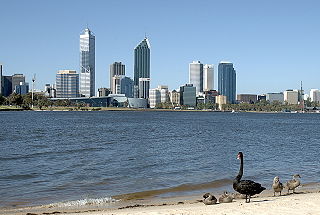
The Swan River is a river in the south west of Western Australia. The river runs through the metropolitan area of Perth, Western Australia's capital and largest city.

Chelodina, collectively known as snake-necked turtles, is a large and diverse genus of long-necked chelid turtles with a complicated nomenclatural history. Although in the past, Macrochelodina and Macrodiremys have been considered separate genera and prior to that all the same, they are now considered subgenera of the Chelodina, further Macrochelodina and Macrodiremys are now known to apply to the same species, hence Chelydera is used for the northern snake-necked turtles.

The white-tailed dunnart(Sminthopsis granulipes), also known as the ash-grey dunnart, is a dunnart native to Australia.

The oblong turtle, southwestern snake-necked turtle or narrow-breasted snake-necked turtle is a species of turtle in the family Chelidae. It is endemic to the southwestern part of Western Australia.

The northern snake-necked turtle or northern long-necked turtle is a species of turtle in the family Chelidae or Austro-South American Side-necked Turtles. It is native to northern Australia and southern New Guinea.

The Baltic region is home to the largest known deposit of amber, called Baltic amber or succinite. It dates from 44 million years ago. It has been estimated that these forests created more than 100,000 tons of amber. Today, more than 90% of the world's amber comes from Kaliningrad Oblast of Russia. It is a major source of income for the region; the local Kaliningrad Amber Combine extracted 250 tonnes of it in 2014, 400 tonnes in 2015.
Perth Canyon is a submarine canyon located on the edge of the continental shelf off the coast of Perth, Western Australia, approximately 22 kilometres (14 mi) west of Rottnest Island. It was carved by the Swan River, probably before the Tertiary, when this part of the continental shelf was above sea level. It is an average of 1.5 kilometres (5,000 ft) deep and 15 kilometres (9.3 mi) across, making it similar in dimension to the Grand Canyon.
Sinotympana is an Asian genus of cicadas in the tribe Dundubiini.
Osmakasaurus is a genus of herbivorous iguanodontian dinosaur. It is a basal iguanodontian which lived during the Early Cretaceous period in what is now Buffalo Gap of South Dakota, United States. It is known from the Chilson Member of the Lakota Formation. This genus was named by Andrew T. McDonald in 2011 and the type species is O. depressus.
The coastal plains skink is a species of skinks, found on the Swan Coastal Plain south of Perth, Western Australia.
The Philip L. Boyd Deep Canyon Desert Research Center is one of the original seven of the total 39 sites in the University of California Natural Reserve System. It contains lands originally donated to the University by regent Philip L. Boyd in 1958. The Research Center is contained within UNESCO's Mojave and Colorado Deserts Biosphere Reserve.
Dolichoderus niger is a species of ant in the genus Dolichoderus. Described by Crawley in 1922, the species is endemic to Australia, and can be seen in scrub like habitats in Western Australia, and has been observed in native woodland around the city of Perth.

Cratera is a genus of land planarians found in South America.
Heronidrilus gravidus is a species of clitellate oligochaete worm, first found in Belize, on the Caribbean side of Central America.
Amphidiscella lecus is a species of sea sponge first found at the bottom of shelf, canyon and seamounts of the west coast of Washington, British Columbia and the Gulf of Alaska.
Barbara Baehr is a German research scientist, entomologist, arachnologist, and spider taxonomist. She has described over 400 new spider species, mostly from Australia. She is originally from Pforzheim, Germany.
Pandappa Conservation Park is a protected area located in the Australian state of South Australia in the locality of Franklyn about 200 kilometres (120 mi) north-east of the state capital of Adelaide and about 40 kilometres (25 mi) south-east of the town of Peterborough.
Pooginook Conservation Park is a protected area located in the Australian state of South Australia in the locality of Pooginook about 166 kilometres (103 mi) north-east of the state capital of Adelaide and about 12 kilometres (7.5 mi) north-east of the town of Waikerie.
Amphidiscella is a genus of sea sponge in the family Euplectellidae.
Phyllis Jane Fromont is a New Zealand and Australian scientist specialising in sponges.







